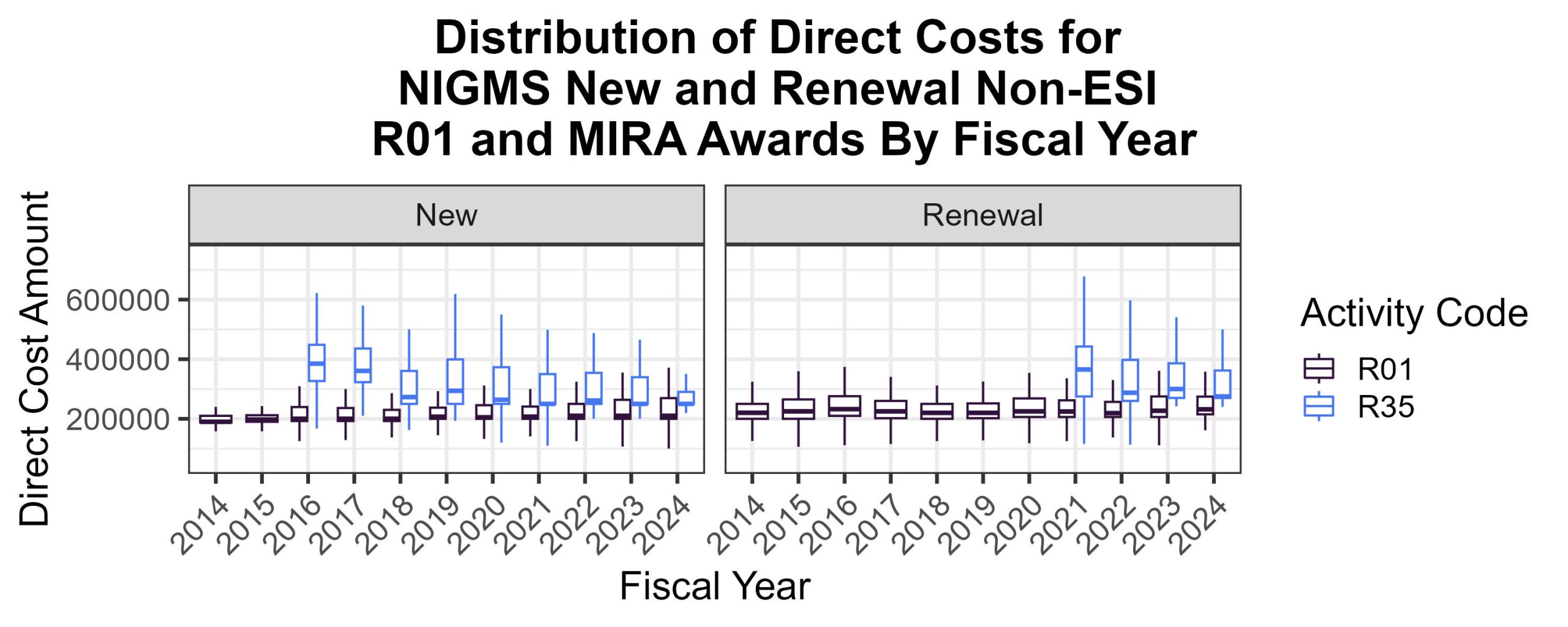What Are the Chances of Getting More Than One NIGMS R01?
Principal investigators (PIs) occasionally tell us they don’t plan to apply for the Maximizing Investigators’ Research Award (MIRA) program because their institutions expect them to have multiple R01 grants and thus they need to stick with R01 funding. To address this issue, we thought it would be useful to examine the likelihood of getting more than one NIGMS R01.
Figure 1 shows the percentage of PIs who held more than one NIGMS R01 between fiscal years 2014 and 2024 (FY14 and FY24). The first MIRA grants were awarded in FY16, so FY14 and FY15 represent years prior to the beginning of the program. In FY14 and FY15, only 16% of PIs had more than one NIGMS R01. This percentage hovered around 14-15% until 2019, when it began declining. The decline was likely the result of an increasing number of PIs converting their R01s to MIRAs and an Institute policy that PIs could not have more than two NIGMS R01s. Importantly, even before the MIRA program started, only a small fraction of PIs had more than one NIGMS R01. These data are consistent with an analysis we performed previously of how many early stage investigators (ESIs) who were awarded NIGMS R01s between FY04 and FY15 obtained a second NIGMS R01.
Percent of NIGMS R01 PIs With More Than One R01 By Fiscal Year
Figure 1. The percentage of PIs who have more than one NIGMS R01 by fiscal year. While the percentage of PIs with more than one NIGMS R01 was approximately 16% in FY14, it dropped to approximately 8% in FY24.
We next examined how long PIs who had more than one NIGMS R01 were able to maintain that level of funding. Figure 2 shows PIs who had two or more NIGMS R01s in FY14 and follows their funding levels each year for the subsequent 10 years. We excluded from the analysis investigators who received MIRA grants during this time period. By year 2, only 40% of this group still had two or more R01s, and this percentage dropped over the following years until only 8% of the original pool had more than two R01s in year 9. Thus, of the small fraction of PIs who had two or more NIGMS R01s in 2014, most only stayed at that level of funding for a short period of time, even when those who converted to MIRA are excluded.
Figure 2. Distribution of PIs Who Had More Than One NIGMS R01 in FY14 Who Still Had More Than One R01 in the Subsequent 10 Fiscal Years
Figure 2. The number of PIs who had two or more NIGMS R01s in FY14 who still had two or more R01s in each of the following 10 years (black solid lines). PIs who received MIRA grants in this time period were excluded from the analysis. The percentage of PIs who had two or more NIGMS R01s in FY14 who still had two or more R01s in each of the subsequent years is shown above the bars. The number of R01s held is indicated by the bar color: black, two or more; light blue dashes, one.
Another concern we often receive from PIs is that their institutional leaders want them to apply for R01s instead of MIRA grants because they think they can get higher budgets through R01s. Figure 3 shows the distribution of NIGMS R01 and MIRA budgets for established investigators (that is, not ESIs) from FY14-FY24 for both new and renewal awards. Median MIRA budgets are consistently higher than those for R01s for both new and renewal grants.

Figure 3. Box plots showing the distribution of direct cost amounts for NIGMS R01 (black) and R35 (MIRA, blue) new and renewal grants for established investigators in FY14-FY24.Multi-PI R01 award budgets were adjusted for the number of PIs on the award. FY21 was the first year MIRA renewal awards were made. The boxes represent the 25th(Q1) to 75th(Q3) percentiles and the solid horizontal bars are the median values. The lower whisker is Q1-1.5*(Q3-Q1) and the upper whisker is Q3+1.5*(Q3-Q1).
Almost all ESIs funded by MIRAs have received the maximum direct cost budget of $250,000 per year, which is significantly higher than the median budget for NIGMS ESI R01s of $210,000 per year. We recently published a Guide notice raising the maximum direct cost budget for ESI MIRAs to $275,000 per year for applications submitted for the October 3, 2024, due date and beyond.
Overall, the data presented above make clear that even before the MIRA program started, few PIs had more than one NIGMS R01, and those who did rarely maintained that level of support for long. Institutions might want to revisit policies that expect PIs to have multiple R01 grants with this information in mind. To reflect the current budget situation and the Institute’s priority for funding MIRA grants, we recently updated our funding policies webpage to indicate that NIGMS is unlikely to award more than one R01 to a PI.
In addition to being a year longer, MIRA grants generally have higher budgets than NIGMS R01s, which, coupled with the increased scientific flexibility and higher renewal rates, should make applying for a MIRA instead of an R01 the best choice for most eligible PIs. If you are eligible for MIRA but have been told by a department chair or other senior leader at your institution that you should apply for an NIGMS R01 instead, please feel free to have them contact us so we can explain why this probably isn’t the best strategy.



